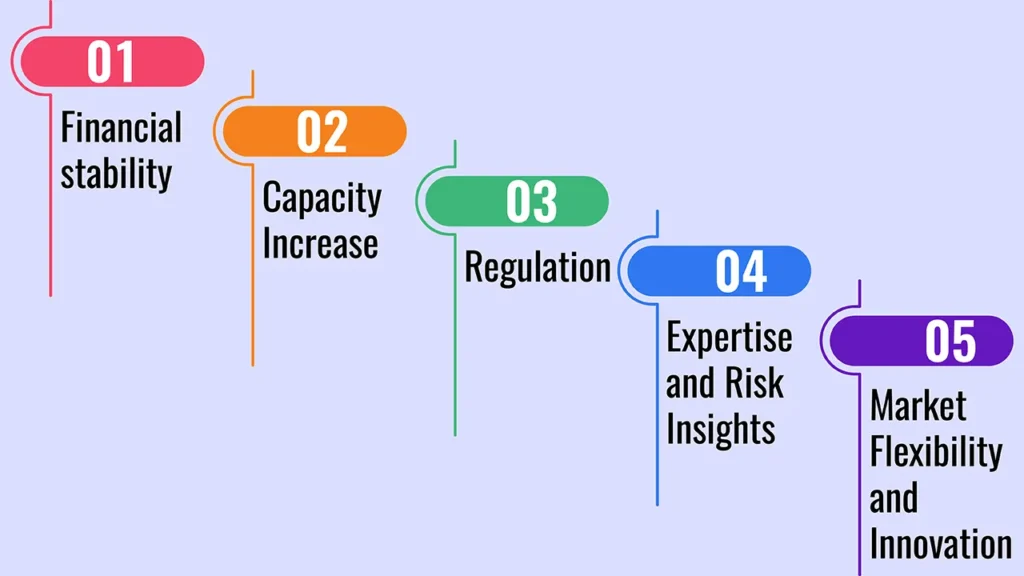At heart, insurance is the business of managing risk – pooling resources so that unexpected losses can be shared. But the insurers themselves are at risk of large or catastrophic losses that threaten their financial stability.
This is where reinsurance is very important. Reinsurance is insurance for insurers, enabling them to transfer some of their risk portfolios to other companies — the reinsurers. This post discusses why reinsurance is important in the stability, solvency, and growth of the insurance industry.
1. What is Reinsurance?
Reinsurance is a contract (insurance policy) in which an insurance company (the ceding company or the reinsured) that has issued an insurance policy agrees to transfer to another insurance company (the reinsurer), some of the liability and premium of the insurance policy it wrote (collateral insurance policy). There are two primary types:
- Facultative Reinsurance: Covers single risks or policies and is typically negotiated on an ad hoc basis.
- Treaty Reinsurance: Provides coverage to a book or block of business automatically in accordance with agreed terms.
By transferring risk to the reinsurer, the insurance company is able to reduce its risk of large claims, ensure that it can meet its capital requirements and quote policies with larger limits or broader coverage.
2. Role of Reinsurance on Risk Management
At its most fundamental, reinsurance admits risk and truncates loss. Other risk include unforeseeable claims. Ekasay/iStockphoto/Getty Images Insurance companies have to deal with random unwanted accident claims, especially from things like hurricanes or quakes. Reinsurance contracts help:
- Cede a portion of the loss to reinsurers, to which the insurer can transfer a portion of all claims so that it does not absorb the full amount on its own.
- Steady underwriting results by reducing spikiness in claims.
- Give financial support to make an insurer solid enough to be trustworthy.
By spreading risk more efficiently, reinsurance helps to offset the financial burden of high-cost claims and protect insurers’ balance sheets – to the ultimate benefit of policyholders and the maintenance of a healthy insurance market.
3. The Advantages of Reinsurance to the Insurance Companies

Insurers enjoy several benefits of reinsurance:
- Financial stability: Insurers can make losses less volatile and safeguard their solvency margins. That safety net is particularly crucial when claims rise during natural disasters or economic downturns.
- Capacity Increase: Reinsurance can provide broader coverage for insurers, allowing them to underwrite additional policies or higher coverage limits without having to some higher extent than otherwise increase their capital base.
- Regulation: Several states have set minimums for an insurance company’s capital. By facilitating the transfer of risk off their balance sheets and freeing up capital, reinsurance enables insurers to comply with those rules.
- Expertise and Risk Insights: Reinsurers often provide extensive experience and advanced skills in analyzing data to help insurance companies better evaluate risks, develop more-accurate pricing, and mitigate losses.
- Market Flexibility and Innovation: With the protection of reinsurance, insurers are more willing to innovate and build new insurance products or break into new markets.
Collectively, these advantages allow insurers to more efficiently and with greater confidence compete in the marketplace.
4. How Reinsurance Works to Help the Insurance Market
The insurance ecosystem will be more robust with reinsurance. It promotes innovation by letting insurers venture into new lines of coverage with manageable risks for catastrophic losses. Consumers win since carriers are able to provide broader coverage and higher limits supported by unparalleled financial security.
Reinsurance stimulates competition, as small firms can compete with large firms, and it increases market diversity and stability further by mutualising risk. Moreover, reinsurers contribute to market stability in the wake of major catastrophe events by dispersing financial impacts internationally, contributing to swifter recovery and retention of confidence in insurance products.
5. Examples of Reinsurance in the Real World
Natural disasters offer some of the clearest examples of the importance of reinsurance. When hurricanes, earthquakes or floods hit, insurers are faced with a tidal wave of claims that could swamp even a single company.
Reinsurers absorb large parts of these losses, and insured individuals and businesses receive payment of claims regardless of insurer insolvency. For example, after a severe hurricane, reinsurers may pick up a large share of the property damage claims, allowing the primary insurer to emerge economically stable and able to pay future claims.
This device lets insurance companies and policyholders know that even in the middle of a crisis, they will still be protected.
6. Reinsurance: Typical Issues and Considerations

However, despite its importance, reinsurance is not all a bed of roses:
- Price: Reinsurance isn’t cheap, and riskier portfolios or fluctuating markets can result in costlier terms.
- Complications: Policies can also get complex and often need skilled negotiation to address the conditions of coverage, retention, and claims.
- Market Cycles: The availability and the pricing of reinsurance change with economic and catastrophic event cycles, which impacts the insurer’s planning and operations.
- Visibility and Control: Meeting local and global compliance requires robust reporting and governance.
Nevertheless, good reinsurance partners and comprehensive risk management make this type of agreement very attractive for insurers.
7. Emerging and Future Trends in Reinsurance
The reinsurance market is undergoing change as new risks such as cyber threats and climate change challenges emerge. Thanks to the tremendous advances in technology, particularly AI and data analytics, the ability to assess risk and underwrite more precisely is enhanced. The role of captive reinsurance and alternative risk transfer tools, including catastrophic bonds, is increasing.
Meanwhile, more regulation is causing sustainability to play an even greater role reinsurance models of the future. These developments hold the prospect of making insurance markets more resilient and more adaptive, globally.
Conclusion
Reinsurance is critical to the insurance industry and represents the lifeblood that enables the management of risk, financial security, and profitability. It allows insurers to underwrite coverages with certainty whilst protecting their solvency position through the transfer of risk and solvency benefit.
The doctrine of reinsurance only becomes more emergent in today’s intricate insurance environment that is vulnerable to various risks. It create an environment that leads to innovation in the marketplace, and protects consumers so that a strong and sustainable industry continues to exist long past the point where catastrophic losses should have been taken next to large proprietary bets.
Frequently Asked Questions
1. What is reinsurance, and what does it mean for insurance companies?
Reinsurance refers to a process in which insurance companies cede or transfer their risk to other insurers, the reinsurers.
This eases insurance companies’ exposure to huge financial losses, especially during catastrophic events such as natural disasters. It enables them to be financially sound and to be able to offer coverage to their customers without worry.
2. What are the main types of reinsurance?
There are two types of reinsurance mainly – facultative and treaty. Facultative reinsurance applies to single risks, with terms often negotiated risk by risk. There may be a large number of policies than can be treated by reinsurance of a fetreaty type which automatically covers a group or portfolio of risks. Both provide ways for insurers to manage their risk differently depending on what they prefer.
3. What impact does reinsurance have on insurance premiums?
Reinsurance can also make insurance premiums less volatile. By spreading risk with reinsurers, insurance companies can stave off large losses that might otherwise trigger them to quickly raise premiums. This risk-sharing makes it easier for insurers to charge reasonable rates for their policies over time.
4. Must insurance companies have reinsurance?
Reinsurance is not compulsory everywhere but is a key part of how insurers meet regulatory capital needs and prudently manage their financial risk. Many regulators promote or mandate that insurance companies have reinsurance in place to guarantee they have sufficient capital to pay claims from unexpected catastrophic loss events.
5. Can individuals buy reinsurance?
No, reinsurance isn’t what private citizens or ordinary policyholders purchase. It is a business-to-business contract between insurers and reinsurers that safeguards insurers from huge losses. People purchase ordinary insurance policies that may indirectly be covered by reinsurance from insurers.

Leave a Reply